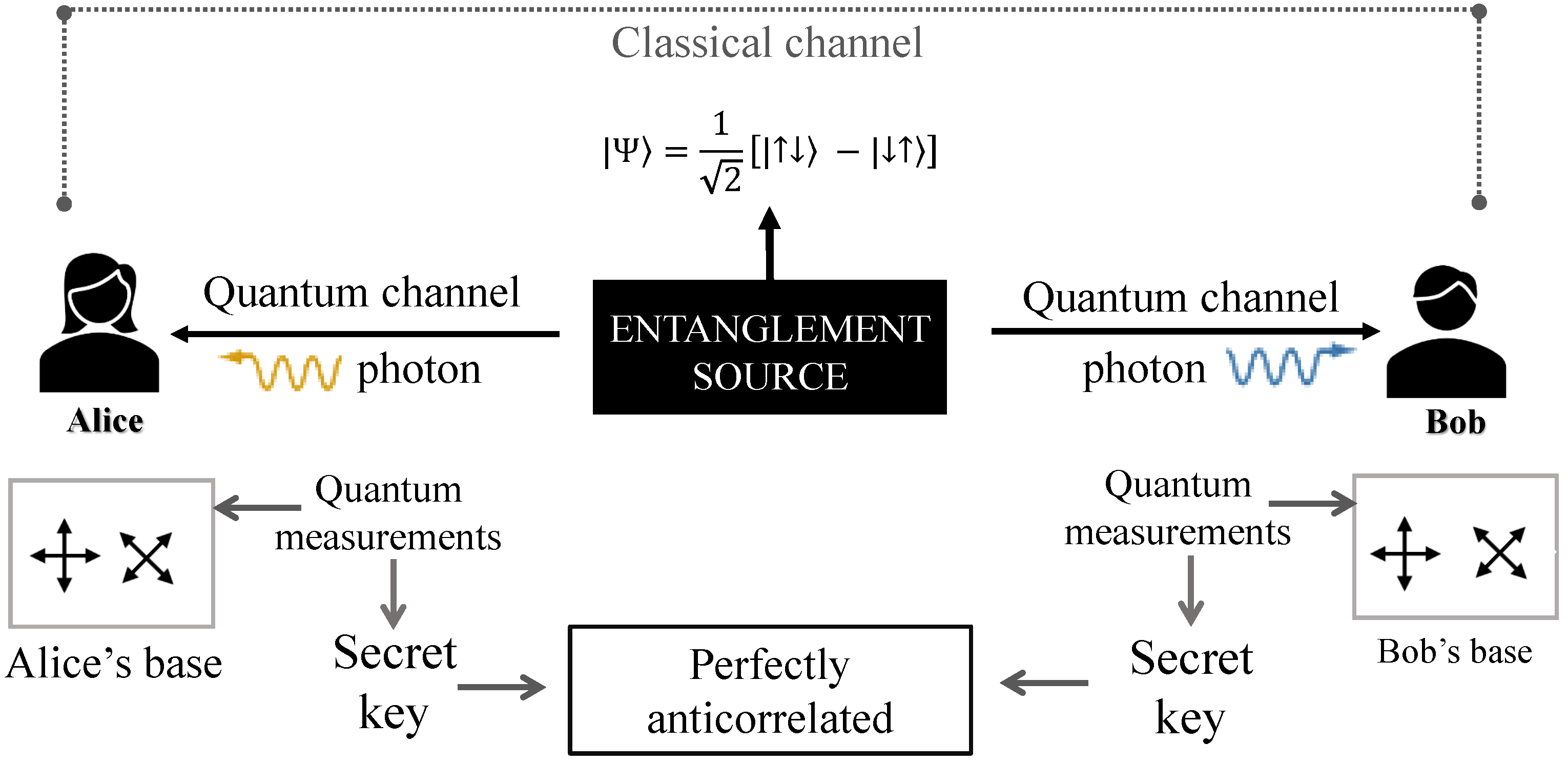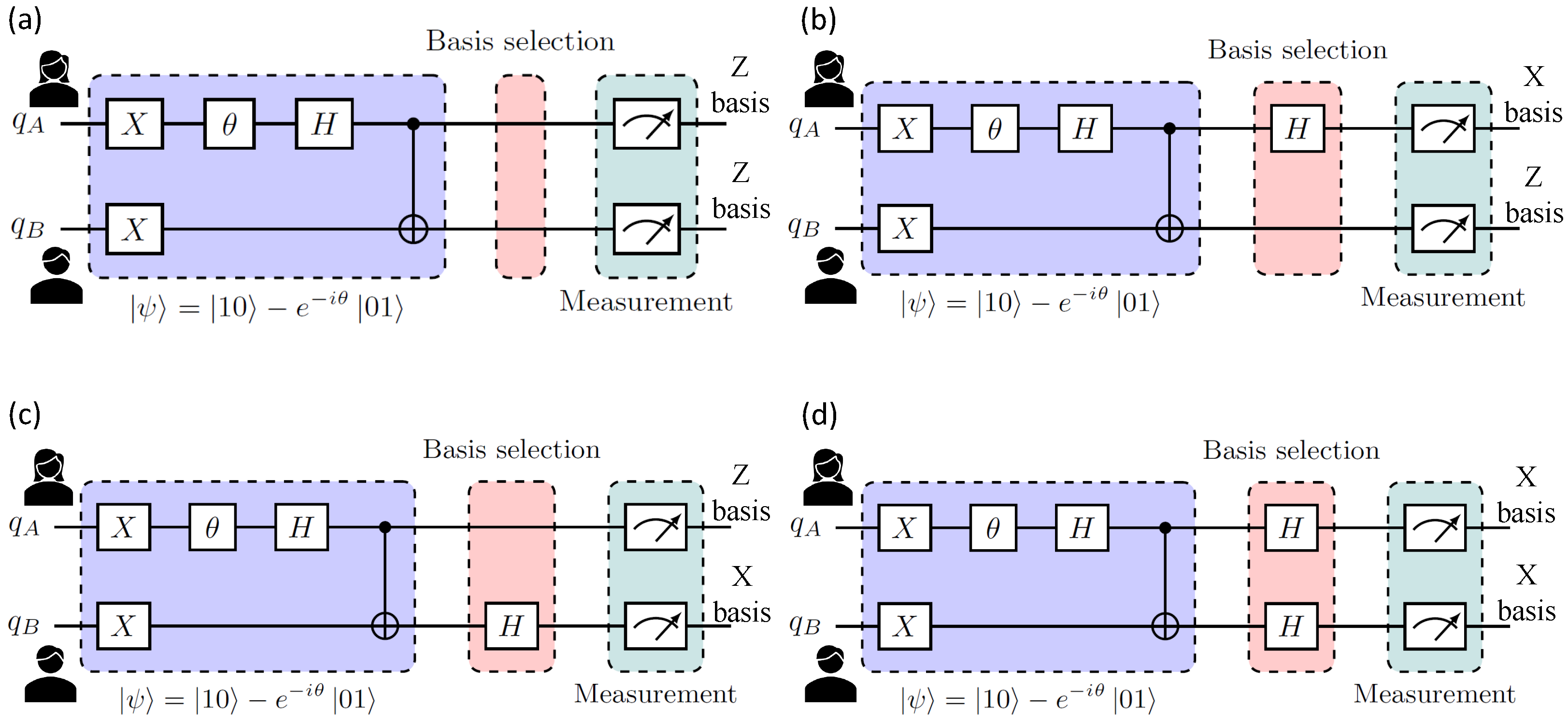Effects of the Exciton Fine Structure Splitting on the Entanglement-Based Quantum Key Distribution
Abstract
1. Introduction
2. Fine Structure Splitting in Quantum Dots
3. BBM92 Protocol for Quantum Key Distribution
Protocol Steps
4. Effects of the FSS in the QKD performance
5. Quantum Computing Implementation
6. Results and Discussion
7. Conclusions
Author Contributions
Funding
Data Availability Statement
Conflicts of Interest
References
- Nielsen, M.A.; Chuang, I.L. Quantum Computation and Quantum Information; Cambridge University Press: Cambridge, UK, 2001. [Google Scholar]
- Scarani, V.; Bechmann-Pasquinucci, H.; Cerf, N.J.; Dušek, M.; Lütkenhaus, N.; Peev, M. The security of practical quantum key distribution. Rev. Mod. Phys. 2009, 81, 1301. [Google Scholar] [CrossRef]
- Couteau, C.; Barz, S.; Durt, T.; Gerrits, T.; Huwer, J.; Prevedel, R.; Rarity, J.; Shields, A.; Weihs, G. Applications of single photons to quantum communication and computing. Nat. Rev. Phys. 2023, 5, 326–338. [Google Scholar] [CrossRef]
- Yin, J.; Li, Y.H.; Liao, S.K.; Yang, M.; Cao, Y.; Zhang, L.; Ren, J.G.; Cai, W.Q.; Liu, W.Y.; Li, S.L.; et al. Entanglement-based secure quantum cryptography over 1120 kilometres. Nature 2020, 582, 501–505. [Google Scholar] [CrossRef] [PubMed]
- Wang, S.; Yin, Z.Q.; He, D.Y.; Chen, W.; Wang, R.Q.; Ye, P.; Zhou, Y.; Fan-Yuan, G.J.; Wang, F.X.; Zhu, Y.G.; et al. Twin-field quantum key distribution over 830-km fibre. Nat. Photonics 2022, 16, 154–161. [Google Scholar] [CrossRef]
- Fan-Yuan, G.J.; Lu, F.Y.; Wang, S.; Yin, Z.Q.; He, D.Y.; Chen, W.; Zhou, Z.; Wang, Z.H.; Teng, J.; Guo, G.C.; et al. Robust and adaptable quantum key distribution network without trusted nodes. Optica 2022, 9, 812–823. [Google Scholar] [CrossRef]
- Berrevoets, R.C.; Middelburg, T.; Vermeulen, R.F.L.; Chiesa, L.D.; Broggi, F.; Piciaccia, S.; Pluis, R.; Umesh, P.; Marques, J.F.; Tittel, W.; et al. Deployed measurement-device independent quantum key distribution and Bell-state measurements coexisting with standard internet data and networking equipment. Commun. Phys. 2022, 5, 186. [Google Scholar] [CrossRef]
- Einstein, A.; Podolsky, B.; Rosen, N. Quantum-mechanical description of physical reality be considered complete. Phys. Rev 1935, 47, 777. [Google Scholar] [CrossRef]
- Grynberg, G.; Aspect, A.; Fabre, C. Introduction to Quantum Optics: From the Semi-Classical Approach to Quantized Light; Cambridge University Press: Cambridge, UK, 2010. [Google Scholar]
- Clauser, J.F.; Horne, M.A.; Shimony, A.; Holt, R.A. Proposed experiment to test local hidden-variable theories. Phys. Rev. Lett. 1969, 23, 880. [Google Scholar] [CrossRef]
- Horodecki, R.; Horodecki, P.; Horodecki, M.; Horodecki, K. Quantum entanglement. Rev. Mod. Phys. 2009, 81, 865–942. [Google Scholar] [CrossRef]
- Hudson, A.J.; Stevenson, R.M.; Bennett, A.J.; Young, R.J.; Nicoll, C.A.; Atkinson, P.; Cooper, K.; Ritchie, D.A.; Shields, A.J. Coherence of an Entangled Exciton-Photon State. Phys. Rev. Lett. 2007, 99, 266802. [Google Scholar] [CrossRef]
- Müller, M.; Bounouar, S.; Jöns, K.D.; Glässl, M.; Michler, P. On-demand generation of indistinguishable polarization-entangled photon pairs. Nat. Photonics 2014, 8, 224–228. [Google Scholar] [CrossRef]
- Vajner, D.A.; Rickert, L.; Gao, T.; Kaymazlar, K.; Heindel, T. Quantum communication using semiconductor quantum dots. Adv. Quantum Technol. 2022, 5, 2100116. [Google Scholar] [CrossRef]
- Pennacchietti, M.; Cunard, B.; Nahar, S.; Zeeshan, M.; Gangopadhyay, S.; Poole, P.J.; Dalacu, D.; Fognini, A.; Jöns, K.D.; Zwiller, V.; et al. Oscillating photonic Bell state from a semiconductor quantum dot for quantum key distribution. arXiv 2023, arXiv:2307.06473. [Google Scholar]
- Stevenson, R.M.; Young, R.J.; Atkinson, P.; Cooper, K.; Ritchie, D.A.; Shields, A.J. A semiconductor source of triggered entangled photon pairs. Nature 2006, 439, 179–182. [Google Scholar] [CrossRef] [PubMed]
- Akopian, N.; Lindner, N.; Poem, E.; Berlatzky, Y.; Avron, J.; Gershoni, D.; Gerardot, B.; Petroff, P. Entangled photon pairs from semiconductor quantum dots. Phys. Rev. Lett. 2006, 96, 130501. [Google Scholar] [CrossRef] [PubMed]
- Bennett, C.H.; Brassard, G.; Mermin, N.D. Quantum cryptography without Bell’s theorem. Phys. Rev. Lett. 1992, 68, 557. [Google Scholar] [CrossRef]
- Schimpf, C.; Reindl, M.; Huber, D.; Lehner, B.; Da Silva, S.F.C.; Manna, S.; Vyvlecka, M.; Walther, P.; Rastelli, A. Quantum cryptography with highly entangled photons from semiconductor quantum dots. Sci. Adv. 2021, 7, eabe8905. [Google Scholar] [CrossRef]
- Schimpf, C.; Reindl, M.; Basso Basset, F.; Jöns, K.D.; Trotta, R.; Rastelli, A. Quantum dots as potential sources of strongly entangled photons: Perspectives and challenges for applications in quantum networks. Appl. Phys. Lett. 2021, 118, 100502. [Google Scholar] [CrossRef]
- Schimpf, C.; Manna, S.; da Silva, S.F.C.; Aigner, M.; Rastelli, A. Entanglement-based quantum key distribution with a blinking-free quantum dot operated at a temperature up to 20 K. Adv. Photonics 2021, 3, 065001. [Google Scholar] [CrossRef]
- Ramirez, H.Y.; Cheng, S.J.; Chang, C.P. Theory of electron–hole exchange interaction in double quantum dots. Phys. Status Solidi (b) 2009, 246, 837–841. [Google Scholar] [CrossRef]
- Ramirez, H.Y.; Lin, C.H.; You, W.T.; Huang, S.Y.; Chang, W.H.; Lin, S.D.; Cheng, S.J. Electron–hole symmetry breakings in optical fine structures of single self-assembled quantum dots. Phys. E Low-Dimens. Syst. Nanostruct. 2010, 42, 1155–1158. [Google Scholar] [CrossRef]
- Cheng, S.J.; Liao, Y.H.; Lin, P.Y. Mechanically encoded single-photon sources: Stress-controlled excitonic fine structures of droplet epitaxial quantum dots. Phys. Rev. B 2015, 91, 115310. [Google Scholar] [CrossRef]
- Díaz-Ramírez, J.D.; Huang, S.Y.; Cheng, B.L.; Lo, P.Y.; Cheng, S.J.; Ramírez-Gómez, H.Y. Composed Effects of Electron-Hole Exchange and Near-Field Interaction in Quantum-Dot-Confined Radiative Dipoles. Cond. Matt. 2023, 8, 84. [Google Scholar] [CrossRef]
- Htoon, H.; Furis, M.; Crooker, S.A.; Jeong, S.; Klimov, V.I. Linearly polarized ‘fine structure’ of the bright exciton state in individual CdSe nanocrystal quantum dots. Phys. Rev. B 2008, 77, 035328. [Google Scholar] [CrossRef]
- Htoon, H.; Crooker, S.A.; Furis, M.; Jeong, S.; Efros, A.L.; Klimov, V.I. Anomalous Circular Polarization of Photoluminescence Spectra of Individual CdSe Nanocrystals in an Applied Magnetic Field. Phys. Rev. Lett. 2009, 102, 017402. [Google Scholar] [CrossRef]
- Gong, M.; Zhang, W.; Guo, G.C.; He, L. Exciton Polarization, Fine-Structure Splitting, and the Asymmetry of Quantum Dots under Uniaxial Stress. Phys. Rev. Lett. 2011, 106, 227401. [Google Scholar] [CrossRef]
- Yin, C.; Chen, L.; Song, N.; Lv, Y.; Hu, F.; Sun, C.; Yu, W.W.; Zhang, C.; Wang, X.; Zhang, Y.; et al. Bright-Exciton Fine-Structure Splittings in Single Perovskite Nanocrystals. Phys. Rev. Lett. 2017, 119, 026401. [Google Scholar] [CrossRef]
- Prin, E.; Xia, C.; Won, Y.H.; Jang, E.; Goupalov, S.V.; Tamarat, P.; Lounis, B. Revealing the Band-Edge Exciton Fine Structure of Single InP Nanocrystals. Nano Lett. 2023, 23, 6067–6072. [Google Scholar] [CrossRef]
- Schliwa, A.; Winkelnkemper, M.; Lochmann, A.; Stock, E.; Bimberg, D. In (Ga) As/GaAs quantum dots grown on a (111) surface as ideal sources of entangled photon pairs. Phys. Rev. B 2009, 80, 161307. [Google Scholar] [CrossRef]
- Huber, D.; Reindl, M.; Covre da Silva, S.F.; Schimpf, C.; Martín-Sánchez, J.; Huang, H.; Piredda, G.; Edlinger, J.; Rastelli, A.; Trotta, R. Strain-Tunable GaAs Quantum Dot: A Nearly Dephasing-Free Source of Entangled Photon Pairs on Demand. Phys. Rev. Lett. 2018, 121, 033902. [Google Scholar] [CrossRef]
- Ramírez, H.Y.; Chou, Y.L.; Cheng, S.J. Effects of electrostatic environment on the electrically triggered production of entangled photon pairs from droplet epitaxial quantum dots. Sci. Rep. 2019, 9, 1547. [Google Scholar] [CrossRef]
- Huo, Y.; Rastelli, A.; Schmidt, O. Ultra-small excitonic fine structure splitting in highly symmetric quantum dots on GaAs (001) substrate. Appl. Phys. Lett. 2013, 102, 152105. [Google Scholar] [CrossRef]
- Huber, D.; Reindl, M.; Aberl, J.; Rastelli, A.; Trotta, R. Semiconductor quantum dots as an ideal source of polarization-entangled photon pairs on-demand: A review. J. Opt. 2018, 20, 073002. [Google Scholar] [CrossRef]
- Qiskit Contributors. Qiskit: An Open-Source Framework for Quantum Computing. 2023. Available online: https://qiskit.org/ (accessed on 1 July 2023).
- Chang, W.L.; Vasilakos, A.V. Fundamentals of Quantum Programming in IBM’s Quantum Computers; Springer: Berlin/Heidelberg, Germany, 2021. [Google Scholar]
- Ramírez, H.Y.; Cheng, S.J. Tunneling Effects on Fine-Structure Splitting in Quantum-Dot Molecules. Phys. Rev. Lett. 2010, 104, 206402. [Google Scholar] [CrossRef]
- Plumhof, J.D.; Trotta, R.; Rastelli, A.; Schmidt, O.G. Experimental methods of post-growth tuning of the excitonic fine structure splitting in semiconductor quantum dots. Nanoscale Res. Lett. 2012, 7, 336. [Google Scholar] [CrossRef] [PubMed][Green Version]
- Schumacher, S.; Förstner, J.; Zrenner, A.; Florian, M.; Gies, C.; Gartner, P.; Jahnke, F. Cavity-assisted emission of polarization-entangled photons from biexcitons in quantum dots with fine-structure splitting. Opt. Express 2012, 20, 5335–5342. [Google Scholar] [CrossRef] [PubMed]
- Fognini, A.; Ahmadi, A.; Daley, S.J.; Reimer, M.E.; Zwiller, V. Universal fine-structure eraser for quantum dots. Opt. Express 2018, 26, 24487–24496. [Google Scholar] [CrossRef] [PubMed]
- D’Ariano, G.M.; Paris, M.G.; Sacchi, M.F. Advances in Imaging and Electron Physics, Chapter 4: Quantum Tomography; Elsevier: Amsterdam, The Netherlands, 2003. [Google Scholar]
- Cramer, M.; Plenio, M.B.; Flammia, S.T.; Somma, R.; Gross, D.; Bartlett, S.D.; Landon-Cardinal, O.; Poulin, D.; Liu, Y.K. Efficient quantum state tomography. Nat. Commun. 2010, 1, 149. [Google Scholar] [CrossRef]




Disclaimer/Publisher’s Note: The statements, opinions and data contained in all publications are solely those of the individual author(s) and contributor(s) and not of MDPI and/or the editor(s). MDPI and/or the editor(s) disclaim responsibility for any injury to people or property resulting from any ideas, methods, instructions or products referred to in the content. |
© 2023 by the authors. Licensee MDPI, Basel, Switzerland. This article is an open access article distributed under the terms and conditions of the Creative Commons Attribution (CC BY) license (https://creativecommons.org/licenses/by/4.0/).
Share and Cite
Hernández-Borda, A.F.; Rojas-Sepúlveda, M.P.; Ramírez-Gómez, H.Y. Effects of the Exciton Fine Structure Splitting on the Entanglement-Based Quantum Key Distribution. Condens. Matter 2023, 8, 90. https://doi.org/10.3390/condmat8040090
Hernández-Borda AF, Rojas-Sepúlveda MP, Ramírez-Gómez HY. Effects of the Exciton Fine Structure Splitting on the Entanglement-Based Quantum Key Distribution. Condensed Matter. 2023; 8(4):90. https://doi.org/10.3390/condmat8040090
Chicago/Turabian StyleHernández-Borda, Adrián Felipe, María Paula Rojas-Sepúlveda, and Hanz Yecid Ramírez-Gómez. 2023. "Effects of the Exciton Fine Structure Splitting on the Entanglement-Based Quantum Key Distribution" Condensed Matter 8, no. 4: 90. https://doi.org/10.3390/condmat8040090
APA StyleHernández-Borda, A. F., Rojas-Sepúlveda, M. P., & Ramírez-Gómez, H. Y. (2023). Effects of the Exciton Fine Structure Splitting on the Entanglement-Based Quantum Key Distribution. Condensed Matter, 8(4), 90. https://doi.org/10.3390/condmat8040090







